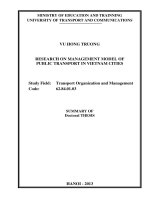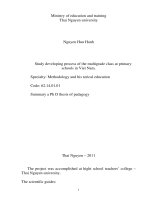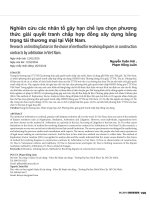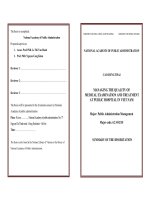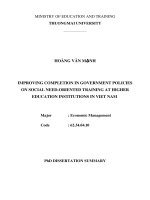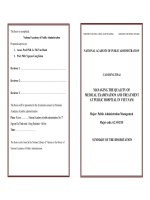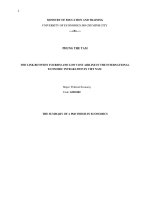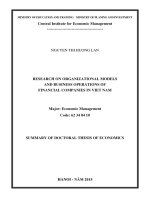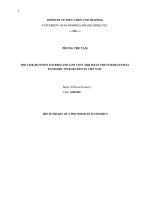Summary of doctoral thesis: Research on management model of public transport in Viet Nam cities
Bạn đang xem bản rút gọn của tài liệu. Xem và tải ngay bản đầy đủ của tài liệu tại đây (297.38 KB, 27 trang )
MINISTRY OF EDUCATION AND TRAINNING
UNIVERSITY OF TRANSPORT AND COMMUNICATIONS
VU HONG TRUONG
RESEARCH ON MANAGEMENT MODEL OF
PUBLIC TRANSPORT IN VIETNAM CITIES
Study Field:
Code:
Transport Organization and Management
62.84.01.03
SUMMARY OF
Doctoral THESIS
HANOI - 2013
Training Institution: University of Transport and Communications
Supervisor: PROFESSOR. Nghiêm Văn Dĩnh (Dr.Sc)
Examination Committee Member 1: ......................................................
................................................................................. ...........................
Examination Committee Member 2: ......................................................
................................................................................. ...........................
Examination Committee Member 3: ......................................................
................................................................................. ...........................
The thesis is defended in front of Examination Committee at University Level
In : .....................................................
At ....... , ..... ..... …….. 2013
The thesis can be found in the Information Center of Hanoi University of
Transport and Communications.
LIST OF AUTHOR’S RESEARCHES PUBLISHED
1- Hans Orn, Vu Hong Truong: Urban transport changes in a Reform Economy:
The case of Hanoi; Asia pacific Journal of Transport - Volume 1/1996.
2- Vu Hong Truong: Development of public bus in Hanoi – the solution to
minimize the negative impacts to environment; Green Road Journal – June 1999
3- Vu Hong Truong: Urbanization – Risks and Challenges on Urban Transport in
Vietnam; Vietnam Road and Bridge Journal – June 1999.
4- Vu Hong Truong: Lesson learnt regarding success and failure of public
transport in regional cities; Transport and Communication Journal – September
1999.
5- Vu Hong Truong: Model for rationalizing traffic vehicle structure in big cities
in Vietnam; Transport and Communication Journal – April 2001
6- Vu Hong Truong: Additional fee for motorcycles in Hanoi – in the scientific
and realistic view point; Transport and Communication Journal – October 2001
7- Vu Hong Truong: Lesson learnt and solutions for public bus development in
Hanoi Capital; Transport and Communication Journal – December 2011.
8- Vu Hong Truong: Urban Transport development orients Public transport – the
important factor of urban sustainable development; Transport and communication
Journal – August 2012.
9- Vu Hong Truong: Management model for public passenger transport in the
world and necessary issues for Vietnam; Transport and Communication Journal –
September 2012.
10- Bui Xuan Dung, Nguyen Van Thu, Vu Hong Truong,…: Proposal for
development and management of public passenger transport in Hanoi during
period 1996-2000. City-Grade Science Study – Hanoi, 1996.
11- Bui Xuan Dung, Nguyen Van Thu, Vu Hong Truong, ... : Develop the
organizational and management model for taxi service in Hanoi – Hanoi
Department of Public Transport, 1998.
12- Nghiem Van Dinh, Nguyen Van Thu, Tu Sy Sua, Vu Hong Truong: Strategies
and development model for urban transport in the big cities in Vietnam orients the
industrialization and modernization. Government – grade Study code KHCN 1002, MOT 2000.
13- Vu Hong Truong: Determine the main solutions for rationalizing traffic
vehicle structure in large scale urban areas in Vietnam. Ministry – Grade Scientific
Study – Hanoi 2001.
1
INTRODUCTION
1- The need for this study
After two decades of innovation, Vietnam has obtained a number of great
achievements in socio-economic development. The average economic growth rate
during period of 1990-2011 is approximately 7.6% per year, which leads Vietnam to
become the developing business destination and attracting foreign investment and
reaching the social development goals.
The rapid economic growth and urbanization lead to the boom of traffic demand in
urban areas. This is the valuable opportunity as well as threat for the development of
urban transport system. On the basis of recognizing such issues, right from the
beginning of 1990s, the Government and big cities’ authority have been making big
efforts to establish appropriate tools in order to solve issues related with urban traffic,
in which public transport development is considered as the key solution. Before 2000,
bus service only existed in Hanoi and Ho Chi Minh City, but currently bus service is
developed in almost big cities in Vietnam.
In Hanoi, in comparison with 2001, the number of buses has been increased by 4
times, and the number of bus passengers increased by 30 times from 15.2 million in
2001 to 445 million in 2011 which is similar to the growth rate in Ho Chi Minh City.
Currently, the public transport management models have been established in Ha Noi
and Ho Chi Minh City with a public transport management and operation center under
DOTs to implement the function of state management while the bus transport
enterprises are responsible for operating and supplying bus services.
However, the public transport management and operation centers do not really
have sufficient ability to prepare and implement the master plan (managing big
investment projects) due to lack of legal authority and practical capacity.
Currently, in two big cities, development projects of mass public transport are
implemented without any agency having sufficient mandate for managing mass public
transport development. The development of such transport mode will easily lead to the
differences and risks of inconsistency as well as lack of connection among public
transport routes in the same network and among different modes.
In summary, the actual situation and development of public transport requires a
sufficient and systematic study in order to construct a management model for public
transport in Vietnam cities applicable in different development periods.
2- Purposes of the study
Systematizing the basement for state management in urban public transport, in
which development strategies, functions, tasks, and forms of management model are
2
deeply analyzed and systematized. Based on arguments applied to evaluate the
actualities and analyze the state management models for public transport in Vietnam
cities, the research clarifies which contents are necessary to be further studied.
Constructing and proposing state management model in public transport applicable
for Vietnam cities in corresponding with condition and development of urban areas in
Vietnam up to 2020, and oriented towards 2030.
3- Objects and scope of the study
The objects of study are: urban public transport system, focusing in state
management issues for public transport such as definition and roles of public transport
in urban areas, economic technical characteristics of public transport modes, state
management for urban public transport, forms of state management model for urban
public transport.
Scope of study: the public transport modes such as bus, metro, BRT, etc. The
enterprise management model is not studied but only the state management model in
public transport is studied for certain range of Vietnam cities (urban areas grade III and
upper). The main cities investigated are Hanoi, Ho Chi Minh City, Da Nang, Hai
Phong, Can Tho and other cities grade III (cities belong provinces). The data
investigated and analyzed in the study are mainly in 2011 and previous years, a few of
data has been updated in 2012. The proposal of solutions is prepared for the period to
2020, oriented towards 2030.
4- Scientific and realistic contribution of the study
Scientific contribution: to systematize the bases of state management model in
urban public transport and clarify the significant issues raising to Vietnam cities; to
analyze and clarify the socio-economic characteristics and nature of traffic demand,
vehicles, infrastructure, etc. in Vietnam cities which are basis of constructing and
improving the state management model for public transport in corresponding for each
development period until 2020, oriented towards 2030.
Realistic contribution: to show disadvantages and inadequate issues in current
management model of public transport in Vietnam cities; to propose recommendation
to help cities’ authority in application of management model based on the
appropriation with development level, public vehicles, and real conditions in each
period of each urban area, firstly in Hanoi and Ho Chi Minh City and then in other
cities in Vietnam.
3
OVERVIEW OF RESEARCH QUESTIONS
a- Analysis and assessment of Vietnam researches:
Recently, the researches in public transport management in our country are mostly
scientific studies such as: Scientific and Technology Program KC10-12 and Scientific
and Technology Program 10-02 of MOT coordinated by University of Transport and
Communication. Some projects financed by abroad organizations also mentioned
urban public transport management issues. Besides, there are some doctoral thesis
studying Public transport. However, there has been no research conducted to fully and
comprehensively study the management model for public transport in Vietnam cities
including all public transport modes
b- Researches in the world:
There are two major forms of management model in public transport including (i)
centralization model: there is a state management agency with overall function which
public transport is operated under the government control; (ii) decentralization model:
the state management agency has the small size with certain several functions while
the public transport services are operated in a competitive market. It is necessary to
review the researches’ results abroad, though it is impossible to apply full results in
Vietnam due to the particular characteristics
c- Objectives of the study
Based on reviewing related research results at home and abroad, the study
completes the theory as well as realistic basement for the state management model of
public transport in Vietnam urban areas.
The study aims at solving inadequate issues of management models which are
currently applied in Vietnam as well as to propose the state management model for public
transport applicable in Vietnam, including all of public transport modes and in
corresponding with each category of urban areas until 2020, oriented towards 2030.
d- Research methodology
In order to achieve proposed objectives, the methodology of dialectical
materialism and historical materialism is applied to comprehensively and objectively
analyze the issues. In the principle of systematic and simulation approach to analyze,
the nature and management of public transport are clarified. By synthesis and
modeling method, the argument of state management model in public transport is
established based on Vietnam reality and pratice.
e- Contents of the study.
Beside the introduction and conclusion parts, the study report comprises of 3 chapters
which are: - Chapter I: Foundation of state management model for urban public
4
transport; - Chapter II: Analysis and evaluation in management model of public
transport in Vietnam cities; - Chapter III: Proposal of state management model for
public transport in Vietnam cities.
Chapter 1: FOUNDATION OF STATE MANAGEMENT MODEL FOR URBAN
PUBLIC TRANSPORT
1.1. Urbanization and urbanization consequences
1.1.1. Overview of Urbanization
Urbanization is a process of works movement from the initial activities to more
focused and centralized activities such as production industry, construction,
transportation, recovery, financial service, socio-culture, science and technology,… It
is also defined as the process of works movement from agricultural activities to nonagricultural focused activities in appropriate areas, so-called urban areas.
1.1.2. Urbanization consequences
(i) Increasing urban population and size of urban areas (ii) Changing the labor
structure of residents (iii) changing the functions of resident areas and regions (iv)
Increasing the settlement and labor fluctuation. Increasing of transport demand and the
pressure of solving urban transport problems as well as environmental assurance
are more complicated.
1.1.3. Urbanization and urban areas classification in Vietnam
According to current regulation, urban areas in Vietnam are cities, county towns
and towns where population is more than 4.000, among which 65% is non-agricultural
labors and classified into 6 urban categories (Special urban area, category I, II, III, IV
and V) based on the urban function, population, area, and other socio – economic
conditions, especial criteria regarding urban infrastructure. The urban areas from
category III are named as “City”.
1.2. Overview of Urban Transport and Public Transport
1.2.1. Urban transport and the roles of urban transport in sustainable urban
development
The “Sustainable development” mentioned in the study is: “the development to
meet human demand at present without influencing the capacity to meet the demand of
future generation”.
Sustainable urban transport development is: Establishing a transport system
which plays a good role in supporting and promoting the urban economic development
while minimizing un-recycled resources usage; Assuring transport rights and fulfilling
transport demand of people at reasonable social expenses; Developing without
environmental pollution and with the assurance of environment protection.
5
Roles of urban transport in sustainable urban development: An urban area can
only sustainably develop with a basement of a sustainable urban transport system, and
vice versa, a sustainable urban transport system has to be located in a sustainable urban
area. Developing an urban transport system with the orientation towards public
transport is an important element in order to solve the above-mentioned issues.
1.2.2. Urban public transport system
Public transport Definition: is a public transport service by different transport
modes in order to meet traffic demands of urban, suburban and regional residents.
According to this criterion, taxi and pedicab services are modes of public transport.
However, in classification of public transport modes, there are 2 categories such as
transport mode based on operational chart (such as bus, metro, etc) and not based on
operational chart.
Private Transport: is an option in which vehicle is directly driven by its owner in
order to serve personal traffic purpose such as personal cars, motorbikes and bicycles.
Components of public transport system are: (i) Vehicles; (ii) Infrastructure; (iii)
Route network; (iv) Driver; (v) Operation. Characteristics of public transport are
considered in aspects of operation scale; vehicles, investment capital; operational
costs; and investment feasibility.
Roles of urban public transport:
- Development oriented toward public transport is the significant factor of
sustainable urban development. It is specified as follow: (i) Considering urban
transport as an object of urban development plan and land use plan. Taking mass
public transport to be a spinal column for urban sustainable development; (ii) the
public fleet planning must be ahead of transport infrastructure planning; (iii)
encouraging the use of public vehicles as well as control the use and ownership of
private vehicles, especially cars.
- Public transport is the significant factor to save time for people’s traffic in the
urban areas, and contributing into increasing social working productivity.
- Public transport contributes in ensuring the safety and health for people.
- Public transport contributes in urban environmental protection.
- Public transport is the factor to ensure the social safeguard.
1.3. Background for state management in urban public transport
1.3.1. Overview of state management in urban transport
The nature of state management in urban area is an intervention of Government in
urban socio-economic development by authority in order to lead urban areas to become
6
the regional centers of economy, politics, culture, technology and international
exchanges.
State management in urban transport is shown in main following aspects:
Establishment and completion of field law system; Issuing policies; Construction
investment planning; Infrastructure maintenance; Technical application and training;
international cooperation, etc.
1.3.2. State management in urban public transport
Main functions of state management in urban public transport:
- Orienting strategies of public transport development in corresponding with
general transport development orientation.
- Public transport development plan preparation must be ensured to be consistent
and compatible with the master plan and transportation plan.
- Creating an equalitarian business environment.
- Regulating, supervising and handling violations.
1.3.3. State management model in urban public transport
State management model definition: is an entity comprising of components which
have certain functions, rights and responsibilities, have interrelationship and be
arranged according to certain phases and levels in order to implement management
function for achieving proposed objectives.
Management model classification:
By the level, management model may comprise of Government level,
City/Provincial level, Department/District level, Division/ Ward level.
By the function, management model comprises of Legislature (National
Assembly), Executive bodies (Government, Ministries, People’s committee), Judiciary
(people’s procuracy, courts of justice)
Forms of management model: In the world, at the local level, there are a number
of basic models including: council-based management model and centralist
management model. Theoretically, there may be a number of management models
such as online management model, function-based management model, online
function-based management model, online consultancy-based management model, etc.
Principles and requirements in constructing the management model: (i)
Management model must serve actual demand with certain benefits; (ii)
correspondence with the principles of social labor division; (iii) ensuring the
consistency; (iv) appropriately dividing authority; (v) clearly determining scope of
management; (vi) ensuring timely and exactly collection of information; (vii)
7
Management model must be in corresponding with characteristics and scope of
managed objects.
Factors affecting management model: Vision and macroscopic policies; Level of
government intervention on the market; Objectives, tasks and rights of agencies;
Political institutions and socio-economic conditions, etc.
Steps of constructing management model:
- Determine the overall goal at the macro level.
- Define state and enterprise management functions.
- Analyze managed objects (public transport system).
- Determine management tools.
- Propose the model (location, name, operational mechanism,...).
- Complete definition of tasks and functions.
1.3.4. Effectiveness evaluation of state management model in urban public
transport
As the new view of approach, it is necessary to evaluate the effectiveness of
management model on both the joint responsibility of divisions as well as the entire
system. A good management model is the model which clearly shows functions and
tasks but not overlap with other divisions’, divisions’ functions and tasks are clearly
defined which clearly assign personal responsibilities, and the process of information
collection and handling as well as decision making is efficiently and effectively
implemented.
Methods to effectiveness evaluation of urban public transport management:
- Statistic Analysis.
- Analytical Hierarchy Process.
- Expert interview method
- Cost Benefit Analysis
- Multi – Criteria Analysis, etc.
Principles to effectiveness evaluation of urban public transport management:
- Evaluating the effectiveness of public transport on the viewpoint of system and
general socio-economic efficiency by shadow price.
- Ensuring the harmony of goal and objectives of each object involved in public
transport system.
- Ensuring the objectiveness of evaluation.
- Evaluating by the viewpoint of development
Norms to evaluate the effectiveness of state management model in public
transport
8
- Norms of evaluating the improvement in accessibility, service quality and
capacity to meet people’s traffic demand.
- Norms of evaluating the assurance of traffic safety
- Norms of evaluating the friendly effect to environment
- Norms of evaluating the uses of energy in public transport
- Norms of evaluating the improvement of investment efficiency and government
subsidy in public transport and the improvement of urban economy.
1.4. Lessons learnt in public transport management from the world
1.4.1. Public transport development policies
In the case of countries clearly defined objective in sustainable development,
public transport is preferred although private transport is still developed. This issue
contributes in parallel development of public transport and private transport, creates a
consistent and combined system of transport which mutually supports for each other
but not mutually conflict.
1.4.2. Intervention level of Government in the market
Recently, the general trend is gradually moving to competitive market in order to
encourage the service providers to reduce expenses. However, in the case of public
transport development to reduce private transport, competitive business model may not
be the best option due to service quality is always considered to reduce business costs.
1.4.3. Regulations for public transport management
The managed objects are mostly similar but the participation of management
agencies may be different depended on the size and complication of public transport
service. Subsidy rates, services quality, service fares, level of synchronization in public
transport are different among urban areas.
1.4.4. Organizational Structure for public transport management
The public transport management models are mostly online-function based
management models. In some large urban areas, the public transport management
agency also have the function of preparing the master plan as well as combination of
urban transport modes.
From the fact of development in the world, the study found out the basic reasons
of success or failure in urban transport development, such as (i) awareness shown in
urban development policy; (ii) master plan; (iii) public transport development; and (iv)
Government regulation role.
Summary of Chapter 1:
In chapter 1, the study generally presented matters related to the public transport
management model. Starting from definitions of urban transport, public transport and
9
its roles in urban sustainable development; then systematizing the theories of public
transport management and organizational model in management, methods to evaluate
the effectiveness of management model; and finally, mentioning the lesson leant from
success and failure in cities’ urban transport development around the world.
Actually, there are many existing/existed management models, each model has
certain advantages and disadvantages. Based on the managerial objectives and specific
condition, an appropriate model is selected.
Chapter 2: ANALYSIS AND EVALUATION IN MANAGEMENT MODEL OF
PUBLIC TRANSPORT IN VIETNAM CITIES
2.1. Current situation of public transport in Vietnam cities
2.1.1. Current situation of public transport in Hanoi Capital
In Hanoi, the public transport has been developed for more than 100 years. It
started when the electric bus system was constructed by French and then developed
into 5 lines with 31.5 km of total length. Electric bus routes became the urban
development routes in Hanoi. Until 1988, electric bus routes were gradually removed
and then there has been only bus system in Hanoi.
Bus system establishment and development history in Hanoi is divided into 4
periods as follows: Hanoi bus system before the Innovation period (before 1986) Crisis
period of bus system (1986-1992); Rehabilitation period of bus system (1993-2001);
and the Total Innovation Period of bus system (2002 up to now)
Development of bus service in Hanoi in the last 10 years:
- Bus service area has been extended with the more and more increasing of
passengers: After 10 years (2001-2011), the number of bus routes is increased 2.1
times, the number of bus vehicles is increased 4.0 times and the number of bus
passengers increased 30 times from 15.2 million in 2001 to 445 million in 2011.
- Bus service positively contributes in decreasing traffic jam and ensuring traffic
safety.
- Capacity of bus operation has achieved high rate of effectiveness and been
reaching the system limitation.
- Bus service quality has been improve
- Organization and mechanism: the operational mechanism of bus service in
Hanoi has been renovated from service provided by state companies to service
provided through contacts with other firms, especially private firms. On the other
hand, a corporation has been established in the appropriate scale with modern facilities
in order to direct the public transport in Hanoi Capital.
10
- However, there are some limitation existing in bus service such as: the overload
of traffic network that leading to the extension of bus trip duration; poor infrastructure
for bus system affecting to the passengers’ accessibility, etc.
2.1.2. Current situation of public transport in Ho Chi Minh City (HCMC)
Before 1990, public transport services in HCMC are mainly bus service and three
– wheeled taxi service which served 20-50 million passengers per year. During the
period from 1990-1997, HCMC rejected the system of state budget subsidies, adopted
the system of business autonomous. This is the slackness period of bus transport
service.
During the period of 1998-2001, the bus transport market is slightly rehabilitated
with 5-15 million passengers per year of ridership. From 2001, bus service has been
rapidly developed due to the implementation of Government subsidy policies such as
encouragement policy in bus vehicles investment, price subsidy policy and other
subsidy policies.
Development of bus service in HCMC in the last 10 years:
- The number of bus routes increased from 97 routes in 2002 to 147 routes in
2010. The total ridership of bus service in 2010 is 364.77 million passengers which
increase 10 times in comparing with 2002. Although the number of bus vehicles did
not much increase but the average capacity significantly increased due to increasing of
high capacity vehicles and decreasing of low capacity vehicles.
- The bus fare is subsidized by HCMC. However, the financial burden on city
budget due to bus fare subsidy is now more and more significant.
2.1.3. Current situation of public transport in Da Nang City
The bus network is comprising of 5 routes with more than 90 medium vehicles in
which the function of 3/5 routes is to connect the center of Da Nang City and 03 towns
of Quang Nam province as surrounding bus routes. The daily bus ridership is about
15,544 passengers (approximately 5.67 million passengers per year). This number is
much lower than expected number as proposal.
2.1.4. Current situation of public transport in Hai Phong City
Currently, there are 12 bus routes serving in Hai Phong City in which most of
routes are serving with the 15-20 minutes of frequency. The most effective route is
Dau Khi Hotel – Do Son Beach route due to the highest ridership.
2.1.5. Current situation of public transport in Can Tho City
Currently, there are 07 serving bus routes. At this time, bus service in Can Tho
city has not been applied subsidy policy, the fuel consumption norms for bus vehicles
11
has not been calculated yet but the bus enterprises are doing business accounting by
themselves.
2.1.6. Current situation of public transport in other cities (grade 3 -urban areas).
For the cities directly under provinces, public bus system is currently in the
beginning and developing period. Bus routes are mostly interprovincial coach routes.
There is no connection among routes that causing the inconveniency for attracting
passengers in order to reduce uses of private vehicles.
2.1.7. Assessment on current situations of public transport in Vietnam cities
Summary of public transport service in Vietnam cities:
No
HCMC
Da
Nang
Hai
Phong
Can
Tho
9
15
83
147
11
5
1
5
12
8
66
108
1
2
-
Route
17
39
4
10
8
Veh.
1.254
2.951
108
121
140
Unit
Hanoi
No. of routes
Route
Subsidized routes
Route
Non- subsidized
routes
3
No. of operating
vehicles
4
No. of trips
103trip/year
3.789
4.000
256
370
285
5
Ridership
103 pas.
445.700
316.610
20.000
8.000
10.870
6
Annual subsidy
Mil. VND
922.400
1.269.000
-
3.102
-
69,3%
57%
-
-
-
2.093
4.008
-
510
-
10
6,5
>1
>1
1,2
1
2
Items
No. of Enterprises
7
Subsidy/Cost
%
8
Subsidy/Pas.
Vnd/pas.
9
% meet traffic demand
Advantages: Public Bus service in 2 special cities (Hanoi and HCMC) has began
to meet the people’s traffic demand (served 8-10% cities’ traffic demand) and
contributed in reducing traffic jam and use of private vehicles. The annual bus
ridership increases in the cities. The lower bus fare is advantageous condition to reduce
passengers’ traffic costs.
Weaknesses: In some big cities such as Hai Phong, Da Nang, Can Tho, the bus
service area is small (served 1-2% cities’ traffic demand), especially in urban area
grade 3 (Cities directly under the provinces), bus service is in the beginning period.
Bus service quality has not generally met requirements. Vehicles operating in several
routes are from coaches so they are not reasonable. The training programs for driver
and on bus - service staff are still limited.
2.2. Analysis and evaluation of current situation of public transport management
model in Vietnam cities
12
2.2.1. Current situation of public transport management model in Vietnam cities.
In Hanoi and HCMC: In 1997, the Management and Operation Center for Public
Transportation (MOCPT) was established in HCMC. In 1998, the Transportation
Management and Operation Center (TRAMOC) was established in Hanoi. These
centers are agencies which has revenue and legal personality under DOTs and
responsible to support Director of DOTs in public transport management and
operation. However, the scope of management is mostly public transport by busation
(not including other public transport modes).
In Da Nang City: Public transport is managed and operated by the Da Nang
Public transportation and Traffic signals control Center.
Management model in other cities: State management in public transport by bus
is directly implemented by units under DOT.
2.2.2. Evaluation of management model for public transport in Vietnam cities
In Hanoi and HCMC: These are two special urban areas, so the scale of
management functions and tasks of state agencies is bigger. However, the management
ability of public transport centers in Hanoi and HCMC is still limited which needs to
be improved in the future.
In Da Nang City: The Da Nang Public Transportation and Traffic signals control
Center has just been established thus the management implementation is much limited
and in the step of organization completion.
In other cities: For example in Hai Phong and Can Tho cities, although the
management demand is big enough to establish an independent management agency
but the management tasks are still directly implemented by units under DOTs. In the
cities belong directly to provinces, bus service has been created. However, the number
of routes is few; therefore, it is reasonable that DOTs directly implement the public
transport management task. However, the implementation of public transport planning
and development policies in these cities still has not been put in an appropriate
consideration yet.
2.3. Issues to be solved in public transport management in Vietnam cities
2.3.1. Macro management policies in public transport development
There are a number of certain encouraging policies for developing public transport
but they are not enough and inconsistent. The reasons of not enough are because the
service and public transport infrastructure have not been much considered in
establishment of policies yet (such as pedestrian sides, sidewalks, Bicycles road lanes,
etc.). The inconsistency is shown in institutional methods of managing private
vehicles, which have not been significantly applied yet.
2.3.2. Orientation of Government in stakeholder structure participates in public
transport market
13
Currently, in some big cities such as Hanoi city, the Government is still basically
controlling the supply of public transport service. How will the matter be oriented in
the future? For example, at which level will state owned enterprises be privatized in
the field of public transport in Hanoi; and in HCMC, how will the Local Government
solve the actualities in order to ensure the main roles of Local Government?, etc.
2.3.3. Management regulations in public transport
The basic issue is quite similar in management regulation among cities while
characteristics of public transport are actually different depending on different types of
city. This is the reason why the management regulations are not practiced or low
efficiency.
2.3.4. Decentralization of management in public transport
Public transport management agency has limited rights in public transport due to
its administrative boundary while public transport routes is also across out of this
boundary, thus there are many issues related with surrounding area which could not be
solved by management agency. Besides, the public transport management agency do
not implement the function of land use planning thus the development of public
transport is based on the actual demand but not based on the long - term plan leading
to the low efficiency of implementation.
2.3.5. Management and function implementation model of state management
agencies in public transport
There is overlap in several management contents among MOT, DOT and the
public transport management agencies. DOT is the agency managing all of situations
but it is not only responsible for public transport, thus the decision may not be feasible.
The centers of management and operation in public transport have not enough rights to
combine public transport modes in the cities.
In the cities directly under provinces, there are no management agencies
responsible to manage public transport but the management is directly implemented by
units under DOT. Ở các thành phố trực thuộc tỉnh, mô hình phổ biến hiện tại là khơng
có cơ quan quản lý VTHKCC mà việc quản lý VTHKCC được thực hiện trực tiếp bởi
các phòng ban của sở GTVT.
Summary: In chapter 2, based on the results of investigation and analyzing the
statistic data, the study can be summarized as follows:
(1) The establishment of the MOCPT in HCMC and the TRAMOC in Hanoi is
practical demand as well as showing the intention of cities’ leaders in promoting
public transport following the Government strategy to reduce traffic jam and improve
traffic safety. During 15 years of existing and developing, the positive roles of the
management center model are shown in developing the public transport system in
Hanoi and HCMC.
14
(2) Beside positive results, the public transport management model in Vietnam
cities is showing the limitation and problems which are not reasonable with the
requirements of public transport development. Details are shown as follow:
- The public transport management in Vietnam cities is just focusing on public
transport by bus. The management roles in development and operation other public
transport modes such as BRT, Metro, etc. has not been defined for these management
agencies yet.
- The preparation of transport plan regarding development of public transport in
the cities is now at low level.
- The percentage of responding traffic demand by public transport is much lower
than proposed goals as the plan to 2020.
No
1
2
3
4
5
6
City
Hanoi Capital
HCMC
Hai Phong
Da Nang
Can Tho
Cities directly under provinces
Percentage of people using public transport
Current status
As the plan to 2020
10.0%
30-35%
6.5%
20-25%
1.0-1.5%
1.5-2.0%
10-15%
1.0- 1.5%
< 1.0%
3-5%
(3) The main reasons of these issues are: the management model has not been
appropriate with actual condition yet; the management decentralization is still not
reasonable; the overlap of function and tasks; and the incompatibility between
functions – tasks and rights – responsibility, etc.
Chapter 3: PROPOSAL OF STATE MANAGEMENT MODEL FOR PUBLIC
TRANSPORT IN THE VIETNAM CITIES
3.1. Orientation for the development of urban areas and urban transport in the
Vietnam cities
3.1.1. Urban development policies in Vietnam
In order to reach the country of prosperity and friendly environment, urban areas
are searching a future to become the live-able cities with the sustainable environment,
developed economy and harmonious society. The proposal of urban development in
Vietnam until 2020 and orienting towards 2030 is: preventing the trend of
development in which huge independent cities with multi-functions are developed, but
increasing the small and medium cities; creating municipal of cities.
3.1.2. Orientation for the development of urban transport in the Vietnam cities
Goals of urban transport development in Vietnam: To ensure the smoothness
of traffic responding all of traffic demands; to ensure the traffic safety for all traffic
15
activities; to decrease negative impact to environment; to promote the development of
urban and suburban economy.
Orientation for the policies in development of transport modes under urban
transport system: (i) Prioritizing to development of public transport, (ii) Encouraging
and guarantee non-motorized vehicles, (iii) Minimizing the use of private motorized
vehicles, (iv) Improving the connection among transport modes, (v) Improving the
multimodal transport, (vi) Improving the freight transport.
3.1.3. Policies and mechanism for development of public transport
(1) Developing the public transport based on the “Procurement first” principle
(2) Appropriately decentralizing the modes of public transport in the cities in order
to ensure the consistency and smoothness of transport system.
(3) The reasonable participants of public transport market is not only necessary to
ensure the competition and maximum mobilization of socio resources but also to
ensure the effective implementation of regulation roles from Government.
(4) Conducting the reasonable subsidy policy in order to ensure that the public
transport service fare is competitive and motivate to public transport providers.
(5) It is necessary to priority develop the public transport in parallel with control
policies for the appropriate use of private vehicles.
3.1.4. Completion of defining state management functions and enterprises
management functions for public transport in Vietnam cities
State management and enterprises management: In the principle that the
Government is not working in place of enterprises, the study clearly defines the
functions of state agencies in public transport as well as the functions of enterprises
which are self-implemented and self-responsible by enterprises. Besides, there are
functions implemented by cooperation between Government and enterprises.
State management by Central and Local Government: to enhance Local
Government’s rights and responsibilities and reduce the direct intervention of the
Central Government. The Central Government should only focus on construct the
institution frameworks and cooperate with Local Government in preparing the
transport modal plan and supporting for the key infrastructure investment if necessary
in localities.
The decentralization for management agencies in public transport: The study
proposes that in the special urban areas, the management agencies are not only
responsible to control its public transport but also responsible to directly act as an
advisor for the People’s Committees in land use planning which supports to propose
and implement the policies related to public transport.
16
The relationship among Management Agency – Enterprise – Passengers: The
relationship between Management Agency and Enterprise is an equal relationship with
A-B contract in providing the public transport service which related with the real
benefit to passengers.
3.2. Systematization and bases of factors impact to the selection and proposal of
state management model for the public transport in Vietnam cities
Based on the similar characteristics in socio-economic conditions and especially
in demand and traffic vehicles factors as well as infrastructure condition in Vietnam
cities, the study divides the cities into 3 groups which are:
- Group 1: Special - grade urban areas (Hanoi city and HCMC)
- Group 2: comprises of cities directly under the Central Government and urban
areas grade I – II directly under Provinces which the size of population, economic
condition and transport characteristics are similar with cities grade I-II directly under
the Central Government) (hereafter called “Cities grade I –II).
- Group 3: Urban areas directly belong provinces which has not reached the
standards of Category 2 yet and urban areas grade III (Hereafter called “Cities directly
under provinces”)
3.2.1. The socio-economic development in Vietnam cities
Cities around the world in generally and Vietnam cities in particular develop
according to the development law from the low to the high level both in “quality” and
“quantity”. The “quantity” development means the extension of area and population.
The “quality” development means the improvement of life condition and people’s
income. Based on the forecast of annual average GDP growth rate from 6-10%
per/year in Vietnam cities, it only takes more 3-4 years to urban areas grade III’s GDP
achieve the GDP similar in current urban areas grade II. The similar pictures are
figured out for the urban areas grade II and I.
3.2.2. Transport infrastructure characteristics
For the category of special – grade cities (Hanoi and HCMC): land area for
transport is small: percentage of land for transport in Hanoi is 6-7% and in HCMC is
5-6% over total urban land area and unsteady arranged in cities areas.
For the category of cities grade I-II (Hai Phong, Da Nang, Can Tho): Land area
for transport in planed is large but actually the construction rate is low. The system of
ring road has not been completed yet.
For the category of cities grade III (Cities directly under provinces: The
development space is opened, Land area for transport in planed is large but actually the
construction rate is low, account form 1.5 – 3.5%. The urban transport system is
17
establishing and still not completed yet which lacks the smoothness and consistency.
3.2.3. Demand and vehicles characteristics in Vietnam cities
For the category of special – grade cities (Hanoi and HCMC): The density of
population is crowded with the high traffic volume while the density of road network
is unsteady disposed thus the capacity of passenger flow is highly concentrated leading
the heavy burden on traffic roads.
For the category of cities grade I-II: The density of population around the Central
is quite crowded with the medium traffic volume thus the capacity of passenger flow is
highly concentrated leading the traffic issues in certain areas.
For the category of cities grade III (cities directly under provinces): The density
of population around the Central is sparse thus the capacity of passenger flow is not
highly concentrated and then no traffic issue occurs.
For “traffic jam” issue: In the special cities, traffic jam usually occurs. It is
beginning to occur in the urban areas grade I-II such as Hai Phong, Da Nang, Can Tho
Cities but it has not been serious and continuous issue yet.
3.2.4. Argument in requirements and contents of state management for public
transport applicable with different urban categories in Vietnam
Based on the development status of urban areas in Vietnam, the study argues the
requirements and different levels of management for different cities according to cities
size, traffic demands and vehicles.
Results of bases systematization for establishing the public transport
management model applicable for cities in Vietnam are as follow:
Urban categories
Grade III
Grade II, I
Special-grade cities
300
300-5.000
> 5.000
8.000
8.000-15.000
> 15000
<1500 USD
1500-2000 USD
2000-2500 USD
4- Range of most trips
Small range inside urban
area
Medium range inside city
5-Vehicle for trip
May be generated by one May be generated by one or
kind of traffic vehicle
more traffic vehicles
Items
1- Population (1000
people)
2- Density of urban
residents (people/km2)
3- Average GDP
(USD/person/year)
Large range inside city
or region
There are many trips
generated by multi
traffic modes, require
high level of connection
and transit
18
Urban categories
Grade III
Grade II, I
Special-grade cities
Items
Bicycles
Motorcycle
Car (few)
Taxi
6- Main vehicles for trip * In the cities that
population is > 100
thousand people, it is
necessary to operate
standard bus service
Bicycles
Motorcycles
Car (average)
Taxi
Standard bus
Large bus
* In the cities that population
is > 1 mil. people, it is
necessary to study
investment of urban railway
- to ensure the satisfaction
and safety of traffic demand
of people
- to reduce environmental
pollution
- to ensure the vision for the
development of mass public
transport modes in order to
prevent the traffic jam issue
in the future
Bicycles (few)
Motorcycle
Car (a lot)
Taxi
Standard Bus
Large bus
Metro
Urban railway
7- Management
objectives
- to ensure the
satisfaction and safety of
traffic demand of people
- to ensure the vision of
space development plan
for public transport
modes.
- to ensure the
satisfaction and safety of
traffic demand of people
- to reduce traffic jam
issue
- to reduce
environmental pollution
8- Scope of
management
In urban area
In province/city
In urban area
9- Management objects
A less number of
enterprises
A number of enterprises
Lots of enterprises
10- Management tool
Simple
Fairly complex
11- Resource
Limited
Fairly sufficient
12- Authority
Decentralization
Based on normally
management
decentralization
Based on normally
management
decentralization
Modern and very
complex
Diversified and
sufficient
According to special
mechanism
3.3. Proposing management model for public transport applicable to the cities in
Vietnam
3.3.1. Public transport management model applicable to special-grade cities
For this category of cities, the study argues and proposes to improve the Center
of Management and Operation for public transport and enhance the management
function of this kind of agency to establish the Hanoi Public Transport Authority under
City People’s Committee.
19
Management model for public transport in special-grade cities
DOT
Implementing
unit
MOT
City People’s Committee
Strategic & Planning
Grade
Hanoi Public Transport Authority
Divisions under DOT
Providers of bus transport and taxi service
Providers of other transport modes such as urban railway, metro (if any)
National Highway across managed location
Directly management relation
Function based relation
Cooperation Relation
Proposing the organizational structure for Hanoi Public Transport Authority
Dept. of Public Transport
Division of
land use
planning
Division of
public
transport
planning
Division of
ticket
control
Division of
general
coordination
Division of
service
supply
management
Division of
supervision
Division of
infrastructure
mgmt.
Other
divisions
(admin,
accout …
3.3.2. Public transport management model applicable to urban areas grade I-II
The study argues and proposes to apply the model of Management Center under
DOT with some additional functions and tasks.
Management model for public transport in urban areas grade I-II
Strategic & Planning
Grade
City People’s Committee
MOT
DOT
Implementing
unit
Divisions under DOT
Public Transport Operation &
Management Center
Providers of bus transport service
Providers of taxi transport service
Providers of other transport modes service (if any)
Directly management relation
Function based relation
Cooperation Relation
20
Proposing the organizational structure for Public Transport Operation &
Management Center
Public transport Operation & Management Center
Division
of land
use
planning
Division
of public
transport
planning
Division
of ticket
control
Division of
general
coordination
Division
of
service
supply
mgmt.
Division of
supervision
Division of
infrastructure
Planning
Other
divisions
(admin,
account,…)
3.3.3. Public transport management model applicable to urban areas grade III
The study proposes to establish units under a DOT’s division in charge for
public transport management.
Management model for public transport in urban areas grade III
Strategic
&
Planning
Grade
Province People’s Committee
MOT
DOT
Divisions under DOT
Management unit for public transport
Implementing
units
Providers of bus transport service
Providers of taxi transport service
Providers of other transport modes service (if any)
Directly management relation
Function based relation
Combination Relation
3.3.4. Details of functions and tasks of management agency in public transport
applicable to each urban category
The proposed model shows that the management agencies of public transport
may be under different grades of management (City grade, Department grade, or
Division Grade). The management agencies in special-grade cities and grade I-II are
added more authorities and ability to coordinate traffic activities in the whole transport
21
network. Besides, the management agencies are supported to have function in planning
of infrastructure related with public transport, thus it’s the best factor supports to
public transport. The proposal is expected to make good the disadvantages existing of
current management models in Vietnam cities.
3.4. Application of management model for public transport in Hanoi City
The Study proposes to apply the general model following 2 phases as below:
Phase 1 Establishing the management agency for urban railway in Hanoi City
Strategic &
Planning
Grade
City People’s Committee
MOT
DOT
Division under DOT
Implementing
units
Directly management relation
Function based relation
Combination Relation
Mgmt. Agency
for urban
railway
Public transport
operation &
management center
Providers of
urban railway
services and
metro services
Providers of
bus and taxi
services
Phase 2: Merging the management agencies of public transport in Hanoi City
City People’s Committee
MOT
Hanoi Public Transport Authority
DOT
Divisions
under DOT
Providers of
urban railway
services and
metro services
Providers of
bus and taxi
services
Providers of
other
transport
services
(waterway)
3.5. Appraisal of proposed management models
Since the management models have not been applied in real life, the appraisal is
carried out based on qualitative point of view only.
22
Summary of Chapter 3: According to the bases presented in Chapter 1 and
results of analyzing the actualities in Chapter 2, the state management models for
public transport applicable to 3 categories of Vietnam cities in corresponding with
development characteristics and trend of urban areas up to 2020 orients 2030 are
constructed in Chapter 3.
CONCLUSION AND RECOMMENDATION
A. Conclusion
Urbanization is an inevitable and objective trend of the development in many
countries. One of urbanization consequences is the pressure on urban transport
problems, especially in developing countries as Vietnam.
Recently, the traffic density in big cities, especially in Hanoi and Ho Chi Minh
City, is more and more increasing, leading to the situation of increasing traffic
congestion, decreasing average traffic speed, increasing traffic accidents and
environmental pollution at the alarming level. These issues have been becoming heavy
challenges for Vietnam industrialization and modernization process.
In order to solve above issues, one of important solutions is to develop public
transport and to appropriately manage the usage of private vehicles. In which, the
completion of management model for public transport is one of important content to
implement the above strategy.
Based on the need from real life, the study focused on research of state
management model for public transport in Vietnam cities during the period up to 2020
and oriented towards 2030. Contribution results of the study are as follows:
(1) Systematization and diversification of argument foundation for state management
in urban public transport in which the development strategies, function and task and types
of management models, lesson learned from urban transport development in the world are
deeply analyzed and systematized. The new recoveries are:
- Scientific foundation and confirmation: the urban transport development
oriented towards public transport is important factor for urban sustainable
development.
- From general methodological approach, the study concretized the effectiveness
evaluation norms for state management model in urban public transport.
- Summary of lesson learned from the success and failure of urban transport in
the world in aspects of awareness, planning, development of public transport and
intervention roles of Government.
(2) Evaluation on current situation of public transport management model in
Vietnam cities. The new contributions of the study are:
